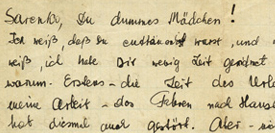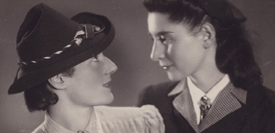Ala Gertner
 “Sarenka, you giddy girl!”
“Sarenka, you giddy girl!”
Ala Gertner’s letters to Sala reveal a bold, modern, and
courageous woman. Well educated and fluent in German, Ala was
assigned to the administrative office at Geppersdorf.
She shared her privileges as one of the camp elite—including
her tiny private room—with her
young friend, Sala. When Ala fell in love with the prisoner
Bernhard Holtz, they recruited Sala to deliver their secret
letters, nicknaming their swift-moving messenger “Sarenka,” Polish
for “little
deer.”
After nearly a year in Geppersdorf, Ala and Sala were allowed
to return home, where the intensity of their friendship was
captured by a local photographer. Sala returned to the camp
alone, Ala
having secured a position with the Judenrat
in nearby Bendsburg. Although separated from Sala, Ala sustained
for two more years a rare, optimistic, loving, and
energetic correspondence. Forced into the Sosnowitz ghetto
in March 1943,
Ala was reunited
with Bernhard and they were soon married. On August 1, the
final liquidation of the Sosnowitz ghetto began.
Ala was sent to Auschwitz, where she worked at the Union Munitions
Factory. She joined an underground conspiracy to smuggle gunpowder
to the Sonderkommando, the work crew that burned and buried corpses
from the gas chambers. On October 7, 1944, the Sonderkommando blew
up Crematorium IV and shot several SS guards. Their revolt was
the only armed uprising at Auschwitz.
 Ala Gertner and Sala Garncarz, September 1941
Ala Gertner and Sala Garncarz, September 1941Most of the men who had escaped after the explosion were recaptured
and killed, and four women—Ala, Roza Robota, Regina Sapirstein,
and Esther Wajcblum—were arrested and charged with acts of
sabotage and resistance. They were tortured and all four were hanged
publicly on January 5, 1945, only a few weeks before the camp was
liberated.
View section images